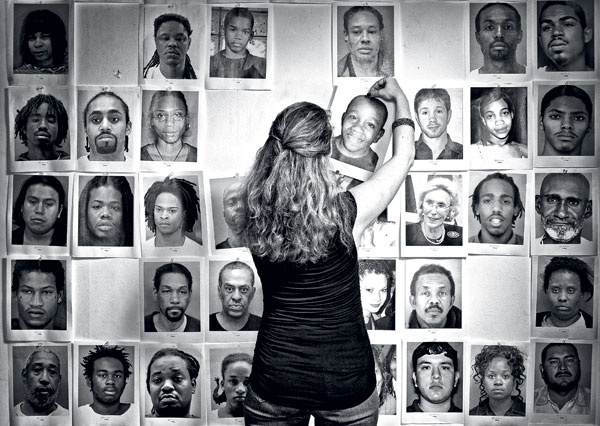
Chris Amico designed and built the Homicide Watch website. Laura does the reporting. Photograph by Douglas Sonders.
When Amico launched Homicide Watch in September 2010, she’d been in DC for just a year. “I wanted to start it quietly,” she says. “I was very aware that I was coming in as an outsider, that this wasn’t my community.”
She began spending days in DC Superior Court and nights writing murder stories, posting documents, and fielding questions or comments.
Laura and Chris Amico had plans to visit his family in Los Angeles that Thanksgiving. They had dated in college, parted company for a few years to work and travel, reunited in Santa Rosa, and married in July 2010. This would be their first holiday with his family.
A murder a few days before they were to head west caught Laura’s attention. She posted this on Homicide Watch: “Metro Police found Gregory Joyner in the 200 block of K Street, SW with a gunshot wound on Monday, Nov. 15.”
She Googled Joyner and found his dating profile on a prison Web site: “I like to travel, workout, listen to music, visit amusements parks and read books. I love eating out and a woman that loves to smile. Due to a cruel twist of fate, I am currently incarcerated and lonely. I have learned from my mistakes and have done what it takes to change my life and prepare for a better future.”
Amico was able to copy and post a photo of Joyner showing off his muscles bursting from his T-shirt, staring through glasses, hair slicked back in cornrows. She combed through Bureau of Prison sites and posted details of his life. She stopped into court to check the public record.
“The charging documents were great,” she says. They described Joyner trying to buy marijuana in a back alley from a man in a wheelchair. Court documents show that a disabled man walking with a cane stood by the wheelchair. They both opened fire on Joyner and kept firing after he fell. Says Amico: “You can just picture the guy rising out of the wheelchair!”
“I’m not sure they were as enthralled as I was,” she says.
Before she left DC, she created a life after death for Gregory Joyner, with links to his MySpace page and a Facebook memorial page.
Over turkey and mashed potatoes in Los Angeles, she wanted to talk about her new endeavor. “Let me tell you about this crazy case,” Amico recalls telling her in-laws.
“I’m not sure they were as enthralled as I was,” she says.
Carl Purvis, the man in the wheelchair, and Timothy Foreman both pleaded guilty to voluntary manslaughter while armed. Prosecutors said the two had shot Joyner because they thought he had robbed Purvis’s brother. When he pleaded guilty, Foreman explained: “I remember pulling out the gun and shooting him. It’s possible I shot him more than once.”
In August, a judge sentenced them to 13 years.
In January 2011, after the Washington Post wrote about Homicide Watch, monthly page views reached 81,000. In August, Chris Amico rebuilt the Web site’s engine. He and Laura added the map marking each murder. In October, monthly page views reached 300,000.
Laura has been working on Homicide Watch full-time for more than a year without pay; the couple lives off Chris’s salary from NPR, where he now works. Their business model calls for marketing Homicide Watch to news organizations.
Laura Amico says they have had discussions with local and regional publications interested in using their software and reporting techniques. As of press time, they were close to finalizing a deal with an out-of-town newspaper.
Laura hopes to bring on interns, which would free her to delve deeper into cases and write longer articles.
“There is a public service to covering violent crime,” she says. “If we know more deeply about who in our community is hurt and who is hurting, when we talk about homicides perhaps we can have more complete conversations, perhaps heal, maybe even prevent.”
On January 5, 2011, Amico posted news on Homicide Watch: “A shooting just before 7:30 this evening in Northeast DC killed one man, according to Metro Police emergency radio traffic and a Washington Post report.”
Four days later, Craig Satcher posted this on Homicide Watch:
“Attention family, friends and loved ones. We are having a candle light ceremony for my brother Nicholas Satcher who was tragically killed protecting his young brother in the house he was raised in and me and my family are asking not to mourn his death but to celebrate his life. Nicholas is a hero who will always be with us.”
A later note asked for donations for the funeral. Craig Satcher left his phone number.
Amico e-mailed Satcher, thanked him for posting, and asked if he wanted to talk. She tries to connect with people who comment on her site. Some respond, some don’t.
“Sure,” he wrote back. “Call me.”
By that time, Ronald Page had been arrested and charged with murdering Nicholas Satcher, his stepson.
When Amico called, Craig Satcher said he was a few years older than his brother Nick, who was 22 when he died.
“Tell me why your brother was a hero,” she said.
“He protected my baby brother,” Satcher said.
“How do you know?
“I was there.”
“What did you see?” she asked.
Satcher said Page was angry that his son—Satcher’s 17-year-old brother—had skipped school. Page stood over him and looked ready to hit him. Nick stepped between them to protect his younger brother. Page grabbed a gun and shot Nick.
“Nick was a hero,” Craig Satcher said. “He was my hero.”
Satcher stayed on the phone with Amico for an hour.
“Thank you,” she said.
“No,” he said. “Thank you for listening. You are the first person who’s asked me what happened.”
Next: “When you go to our site,” he says. “I want you to have an emotional reaction.”



















